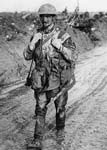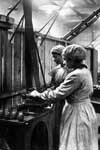
Glasgow munitions workers WW1 © Glasgow Caledonian University Library
International Women’s Day (IWD) emerged at the turn of the twentieth century in Europe and North America. It originated in labour movements and was initially linked to the causes of women workers and suffragists. Since 1913 it has been celebrated annually in various countries on the 8th of March. It has become a day for raising worldwide awareness of the need for women’s equality in the workplace, in education, politics and in the social sphere.
History of IWD

Munitionettes pose with a cairn terrier 1917 © Falkirk Museums
What is now referred to as International Women’s Day started off as the National Women’s Day in 1908 in the US. 15,000 female garment workers marched through New York on strike, demanding better working conditions and the right to vote. In the following year, the US Socialist Party established the women’s day as an annual national celebration.
At the Socialist International meeting in Copenhagen in 1910, over 100 women from 17 countries attended. They agreed to establish Women’s Day as an occasion for speaking out against social, political and economic discrimination towards women.
World War One

VAD Voluntary Aid Detachment, France, WW1 © National Library of Scotland
In Russia, IWD has been held on every last Sunday in February since 1913. On IWD, in the war-ridden year of 1917, Russian women started a mass-demonstration for ‘Bread and Peace’. After four days the Czar abdicated and Russian women were given the right to vote. In the Gregorian calendar this Sunday fell on the 8th of March. It has been the date for the IWD in the rest of Europe ever since, although initially it was mainly celebrated in communist countries. Even though conditions were harsh and most female employees were paid less than their male counterparts, World War I provided an employment opportunity for women on a large societal scale. Most men were away fighting in the war so industries were reliant on the female workforce. Since women needed to make ends meet in the absence of their men, they worked, developed vocational skills and learned to handle financial matters independently.
Education

Girls’ Science Class, Portobello High, Edinburgh, 1914 © The City of Edinburgh Council
Even though women from privileged backgrounds had limited access to university education in Britain from the 1870s onwards, it was several decades until it became more common for women to attend universities and also to be taught science subjects at school. The University of Edinburgh was the first university nationwide to admit women to study medicine (12 November 1862). Yet female students were initially not allowed to graduate and faced much opposition and discriminating regulations. This meant women could not work as professional doctors, with some remarkable exceptions, until decades later.
Cambridge University established two colleges for women in 1869 (Girton College) and 1872 (Newnham College). However, it took until 1947 for women to be accepted as full members of Cambridge university. The first university to admit female students on the same terms as male students was the University College of London in 1878. In the 1960s and 1970s, the second wave feminist movement in the UK addressed issues of gender inequality with a special focus on education. The Sex Discrimination Act of 1975 rendered unlawful the unfavourable treatment of women (or men) based on sex or marriage, at the workplace, in education or training. It had the function “of working towards the elimination of such discrimination and promoting equality of opportunity between men and women”.
Suffrage
Since the 1890s the suffrage movement in Britain had stood up for women’s right to vote. Following the movement’s activities, the Representation of the People Act in 1918 granted electoral rights to women of property, aged 30 years or older. (The Act also meant that men of any social standing were now in a position to vote.) In addition women were officially allowed to stand for parliament. Nancy Astor was the first woman to take her seat in the House of Commons in 1919. Only in 1958, following the Life Peerages Act of that year, were the first women appointed to the House of Lords. In 1928, under the Equal Franchise Act, the right to vote was extended to women of any social standing, aged 21 years and older. Men and women in Britain had finally gained equal electoral rights.
Employment

Jennie Lee, MP in 1947 © Hulton Getty
With increasing opportunities for vocational training and university learning in the 20th century, women have gained wider access to a range of occupations. (eg film director Jill Craigie.) The issue of equal pay for men and women has been addressed by equal rights campaigners since the 1940s (eg politician Jennie Lee) and increasingly so from the 1960s onwards.
Creating opportunities for women to enter a wider range of occupations as well as high level positions in the professional world is still an ongoing topic. To an extent, the objectives of women’s rights campaigners are somewhat in accord with those of the growing gender equality and Lesbian, Gay, Transgender and Bisexual (LGBT) movement. (See also Discrimination – Sexuality.)
International Sport
In the world of international sport, such as the Olympics or Commonwealth Games, women (unlike men) were initially allowed to only participate in a limited number of sport contests. It was not until 1976 that the range of sports offered to women in the Olympics began to increase significantly. Images of female athletes and professional sportswomen then began to become more frequent in the media.
IWD more recently

Scottish Women’s Banner 1996 © The City of Edinburgh Council
In the 1970s the United Nations began organising global IWD events to raise awareness of gender inequality issues. Since then, International Women’s Day has become a more widely-known event to promote female rights in many countries. Governments and women’s organisations worldwide, in the developing and the developed world, now use the day to run training, information and celebratory events.
In Afghanistan, Belarus, Cuba, Georgia, Mongolia, Russia, Uganda, the Ukraine, Zambia, and several other countries, IWD is celebrated as a public holiday.
Images © Glasgow Caledonian University Library, Falkirk Museums, Hulton Getty, The City of Edinburgh Council | Licensor Scran















 Evaluation & moderation is an integral part of the project. Exemplars of pupils’ work will then be used during InSET on as the basis for a school Art & Design moderation. Scran continues to provide support, subject specific knowledge and will also be doing
Evaluation & moderation is an integral part of the project. Exemplars of pupils’ work will then be used during InSET on as the basis for a school Art & Design moderation. Scran continues to provide support, subject specific knowledge and will also be doing 































